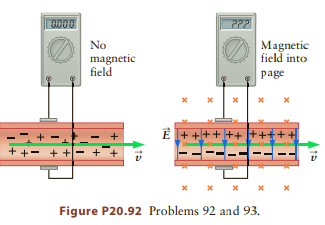Blood-flow meter. Blood plasma has a high content of Na + and Cl - ions, and as
Question:
Blood-flow meter. Blood plasma has a high content of Na+ and Cl- ions, and as the blood follows through a blood vessel, the ions travel along at the same speed as the fluid (Fig. P20.92, left). One method of measuring the blood’s velocity is to place the vessel in a magnetic field and then measure the potential difference across the width of the vessel perpendicular to the magnetic field direction. Unlike the Hall effect, both positive and negative charges here are moving in the same direction, so the magnetic force pushes the positive charges to the top and the negative charges to the bottom as seen in Figure P20.92, right.
(a) Consider the equilibrium condition where the magnetic force on the charges balances the electric force on the charges. Find an expression for the velocity v of the blood in terms of the width d of the blood vessel, the magnitude B of the supplied magnetic field, and the resulting measured electric potential, V.
(b) In designing an actual measuring device for a typical blood-flow velocity of 30 cm/s, an engineer uses an available permanent magnet that supplies a uniform 0.20-T field. We then need to find how sensitive a voltmeter we would need to measure the flow in a small blood vessel. What potential difference would develop across a 1.2-cm-diameter blood vessel with this configuration?

Step by Step Answer:

College Physics Reasoning and Relationships
ISBN: 978-0840058195
2nd edition
Authors: Nicholas Giordano





